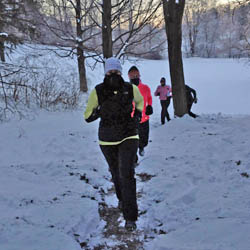
Today is the final day of the LVRS 30-Day Fitness Challenge which took place from January 2 through the 31st. There were 150 people who participated in the challenge, each checked in on a daily or weekly basis and shared their workouts with each other. What did everyone get out of this experience?
MOTIVATION – ACCOUNTABILITY – INSPIRATION
And they are crying for more! Join the February Fitness Challenge and work on your summer body NOW. The rules are simple: move for 30 minutes every single day. It’s that easy. Some days you’ll have a scheduled run, and on your rest day go for a walk. Or do push ups. Something! There is no such thing as not enough time. Last night I did some yoga poses before getting into bed. Five minutes here, five minutes there … it all adds up!
This month you can join the challenge on Facebook or Google+.
Wait a minute! I said TWO challenges, didn’t I?
There is also a second challenge taking place over the next 28 days: The February Nutrition Challenge. The goal for this one is to clean up your diet.
I’m just as guilty as anyone when I say, “I eat healthy,” but what exactly does that mean? I don’t buy junk food but I’ll order a pizza once a week. Mmmm, cheese and artichokes are calling my name right now. In January I tracked every single morsel of food on MyFitnessPal.com – total pain in the butt, I know. But there is a really cool app for those who have a smart phone which makes it so much easier, plus it has a bar code scanner. Anyway, if you are serious about wanting to lose some weight and eat better you can actually track the percentages of protein, fat, cholesterol, fiber, calories, etc. This will help you make smarter food choices and that’s the whole point.
Here are the rules for the Nutrition Challenge:
1. Track your food. You can do this for one day, for one week or the entire month. Even if you do this for one day you will get an idea of what you are actually eating versus how you think you eat.
2. Be honest. There is no need to lie about any of this. If your goal is to lose weight, eat better and/or become healthier then use this group for the support you need. We have all been guilty of pigging out, eating junk food all day long or opting for cookies instead of some yummy carrot sticks at one time or another.
3. Share. Do you have a kick-ass recipe? Share it with us. What did you eat today? Post pictures. Share food ideas.
Two sites to track food and exercise:
MyFitnessPal.com
SuperTracker.com
That’s it. Now, go join the Nutrition Challenge on Facebook or Google+ today!






